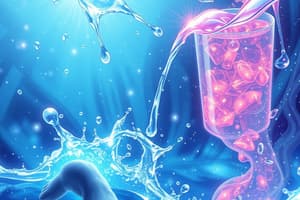Podcast
Questions and Answers
Where is potassium primarily found?
Where is potassium primarily found?
- In blood plasma
- In extracellular fluids
- In cellular debris
- Inside cells (intracellular fluids) (correct)
What is the dominant electrolyte in extracellular fluids?
What is the dominant electrolyte in extracellular fluids?
- Plasma proteins
- Sodium (correct)
- Potassium
- Water
Which of the following can lead to dehydration?
Which of the following can lead to dehydration?
- Overhydration
- Frequent urination
- Increased fluid intake
- Diarrhea (correct)
What causes overhydration or water intoxication?
What causes overhydration or water intoxication?
How does dehydration impact the body?
How does dehydration impact the body?
What is a key factor contributing to dehydration?
What is a key factor contributing to dehydration?
What can induce an electrolyte imbalance in the body?
What can induce an electrolyte imbalance in the body?
Which condition can impair the body's ability to regulate electrolyte levels?
Which condition can impair the body's ability to regulate electrolyte levels?
What is a potential cause of acid-base imbalances in the body?
What is a potential cause of acid-base imbalances in the body?
What is a possible consequence of decreased oncotic pressure in the body?
What is a possible consequence of decreased oncotic pressure in the body?
What is a symptom that may indicate fluid and electrolyte imbalances?
What is a symptom that may indicate fluid and electrolyte imbalances?
How can acid-base imbalances be addressed?
How can acid-base imbalances be addressed?
Study Notes
Fluid and Electrolyte Imbalance
Introduction
Fluid and electrolyte imbalance refers to alterations in the composition or volume of the body's internal fluids, leading to disturbances in the normal functioning of cells, organs, and bodily systems. These discrepancies can be attributed to various factors such as illness, injury, or changes in environmental conditions. This article provides an overview of the key concepts surrounding fluid and electrolyte imbalances, including the causes, effects, and management strategies.
Understanding Fluid Compartments
Body fluids are divided between intracellular and extracellular compartments. Intracellular fluids (ICF) reside inside cells and contain proteins, water, electrolytes, and solutes. Potassium is the primary electrolyte found in ICF. Extracellular fluids (ECF) are located outside cells and consist of blood plasma, plasma proteins, and cellular debris. Sodium is the dominant electrolyte in ECF.
Causes of Fluid and Electrolyte Imbalance
Fluid and electrolyte imbalances can be caused by several factors:
Dehydration
Dehydration occurs when the body loses more fluids than it takes in. This can happen due to increased fluid losses via perspiration, diarrhea, or vomiting. Inadequate water intake or frequent urination can also contribute to dehydration.
Hydration Overload
Overhydration, or water intoxication, arises when the body absorbs too much water without accompanying electrolytes. This imbalance can be induced by consuming excessive amounts of water, especially in situations where the body is unable to effectively eliminate the excess fluid.
Electrolyte Loss
Electrolyte imbalances can occur due to the loss of electrolytes through excessive urination, diarrhea, vomiting, or surgery. Certain medical conditions, such as diabetes, can impair the body's ability to regulate electrolyte levels.
Acid-Base Disruption
Acid-base imbalances can arise from the accumulation of acids or bases in the body due to metabolism, respiratory problems, or poor kidney function. Acidemias (low blood pH) and alkalemias (high blood pH) can both disrupt normal physiological processes.
Oncotic Pressure Changes
Decreased oncotic pressure is often seen in animals suffering from severe gastrointestinal disease, renal glomerular disease, peritonitis, pleuritis, extensive burns, hepatic failure, chronic malnutrition, and severe starvation. Conversely, increased oncotic pressure can occur when the body becomes dehydrated and experiences a decrease in free water.
Symptoms and Clinical Significance
Symptoms of fluid and electrolyte imbalances depend on the particular type of imbalance and its severity. General symptoms can include fatigue, weakness, confusion, muscle cramps, irregular heartbeat, swelling (edema), and seizures.
Treatment and Management Strategies
Treatment for fluid and electrolyte imbalances involves addressing the underlying cause and restoring equilibrium. In cases of dehydration, fluid replacement therapies such as intravenous infusions, oral rehydration solutions, or electrolyte-rich foods may be recommended. Overhydration requires careful monitoring and possibly hospitalization to manage fluid removal methods like restricting water intake or administering diuretics.
For electrolyte imbalances, oral or intravenous replenishment of the missing electrolyte may be necessary. Acid-base imbalances require correcting the underlying issue, such as reversing metabolic acidosis or providing oxygen therapy for respiratory alkalosis.
Prevention Measures
Preventing fluid and electrolyte imbalances involves maintaining proper hydration, moderating salt intake, addressing underlying medical conditions, and seeking prompt medical attention when needed.
Studying That Suits You
Use AI to generate personalized quizzes and flashcards to suit your learning preferences.
Description
Explore the key concepts of fluid and electrolyte imbalances, including causes, effects, symptoms, treatment strategies, and prevention measures. Understand the importance of maintaining balance for normal bodily functions and learn how to identify and manage different types of imbalances.




